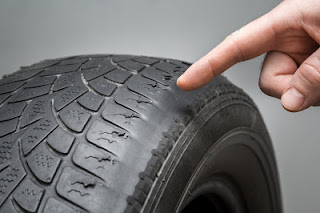Just like your shoes keep your bare feet from touching the ground (ew), your car tires keep your ride from making contact with the ground and going nowhere at all. But, like your shoes encounter everything from glass to gum while you walk around, your tires also encounter many pieces of debris and other hazards in the road and threaten their integrity. Your tires are often ignored until it's too late and you've run into a whole mess of issues. The best way to get to the bottom of what's ailing these essential auto parts is by inspecting the treadwear pattern. At Toyota of Orlando we're here to help you better understand what these patterns mean.
What These Car Tire Treadwear Patterns Mean for Your Ride
Center Wear
Car tires typically wear out evenly all around if they're inflated and driven on properly. If you're starting to notice that the center of your Orlando tire is wearing down at a different pace than the sides, this could be caused by over-inflation. If your tires' pressure is too high look for bulging and excessive wear and let some air out.
Side Wear
Contrary to center wear being caused by over-inflation, under-inflation causes excessive treadwear on the sides of your car tire. If you're someone who's conscientious about how much air you put in your tires, this type of wear can also be caused by a damaged steering arm or faulty alignment.
Cupping Wear
You might not see this type of Orlando car tire treadwear often, but it's easy to spot. Cupping wear looks exactly like it sounds, cup-like divets in your tread. These are often seen on trailer tires that bounce as you drive. If you see this wear on your vehicle's tires it could mean that you're riding on work shock absorbers or are having suspension system issues.
Feathering
This type of tread is a bit difficult to spot visually but you can feel it if you run your hand down the length of your tires' tread. If you feel spots where one side of the tread is sharper or more shallow than the other then you have a feathering problem. This is most often caused by poor wheel alignment and/or aggressive driving behavior.
Sidewall Wear
While it's not directly caused by your driving habits so much as your ability to park, sidewall wear is still important to touch on. When you run your Orlando car tire against a curb or other parking obstruction it can cause damage to the sidewall that results in damage to the tire's overall integrity.
Flat Spot Wear
Highly noticeable and easily felt, large flat spot tread wear can be an indication that you're engaging in bad braking habits. Stop driving and braking harshly and be less aggressive during your commutes. If you dont believe yourself to be an aggressive driver, you could be having brake system issues.
Do you have questions about what these treadwear patterns mean or need auto service for your tires done? Visit Toyota of Orlando at 3575 Vineland Road today!


No comments:
Post a Comment
Note: Only a member of this blog may post a comment.